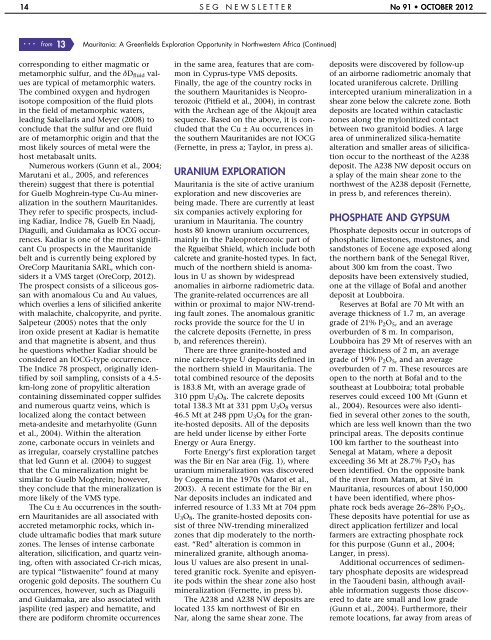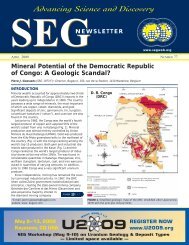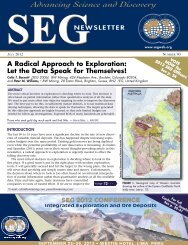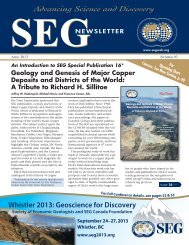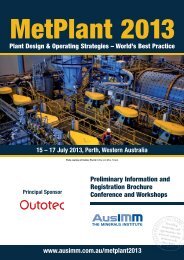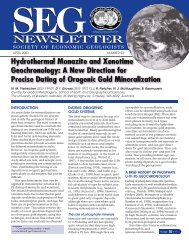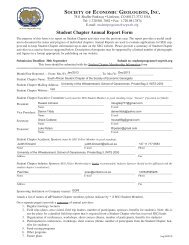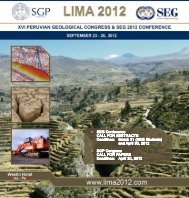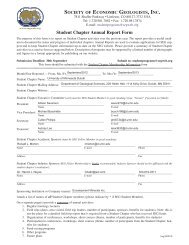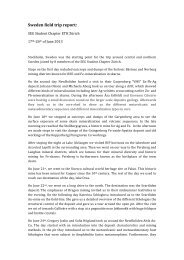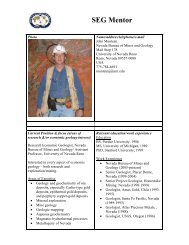SEG - Society of Economic Geologists
SEG - Society of Economic Geologists
SEG - Society of Economic Geologists
You also want an ePaper? Increase the reach of your titles
YUMPU automatically turns print PDFs into web optimized ePapers that Google loves.
14 <strong>SEG</strong> NEWSLETTER No 91 • OCTOBER 2012<br />
... from 13<br />
Mauritania: A Greenfields Exploration Opportunity in Northwestern Africa (Continued)<br />
corresponding to either magmatic or<br />
metamorphic sulfur, and the δD fluid values<br />
are typical <strong>of</strong> metamorphic waters.<br />
The combined oxygen and hydrogen<br />
isotope composition <strong>of</strong> the fluid plots<br />
in the field <strong>of</strong> metamorphic waters,<br />
leading Sakellaris and Meyer (2008) to<br />
conclude that the sulfur and ore fluid<br />
are <strong>of</strong> metamorphic origin and that the<br />
most likely sources <strong>of</strong> metal were the<br />
host metabasalt units.<br />
Numerous workers (Gunn et al., 2004;<br />
Marutani et al., 2005, and references<br />
therein) suggest that there is potential<br />
for Guelb Moghrein-type Cu-Au mineralization<br />
in the southern Mauritanides.<br />
They refer to specific prospects, including<br />
Kadiar, Indice 78, Guelb En Naadj,<br />
Diaguili, and Guidamaka as IOCG occurrences.<br />
Kadiar is one <strong>of</strong> the most significant<br />
Cu prospects in the Mauritanide<br />
belt and is currently being explored by<br />
OreCorp Mauritania SARL, which considers<br />
it a VMS target (OreCorp, 2012).<br />
The prospect consists <strong>of</strong> a siliceous gossan<br />
with anomalous Cu and Au values,<br />
which overlies a lens <strong>of</strong> silicified ankerite<br />
with malachite, chalcopyrite, and pyrite.<br />
Salpeteur (2005) notes that the only<br />
iron oxide present at Kadiar is hematite<br />
and that magnetite is absent, and thus<br />
he questions whether Kadiar should be<br />
considered an IOCG-type occurrence.<br />
The Indice 78 prospect, originally identified<br />
by soil sampling, consists <strong>of</strong> a 4.5-<br />
km-long zone <strong>of</strong> propylitic alteration<br />
containing disseminated copper sulfides<br />
and numerous quartz veins, which is<br />
localized along the contact between<br />
meta-andesite and metarhyolite (Gunn<br />
et al., 2004). Within the alteration<br />
zone, carbonate occurs in veinlets and<br />
as irregular, coarsely crystalline patches<br />
that led Gunn et al. (2004) to suggest<br />
that the Cu mineralization might be<br />
similar to Guelb Moghrein; however,<br />
they conclude that the mineralization is<br />
more likely <strong>of</strong> the VMS type.<br />
The Cu ± Au occurrences in the southern<br />
Mauritanides are all associated with<br />
accreted metamorphic rocks, which in -<br />
clude ultramafic bodies that mark suture<br />
zones. The lenses <strong>of</strong> intense carbonate<br />
alteration, silicification, and quartz veining,<br />
<strong>of</strong>ten with associated Cr-rich micas,<br />
are typical “listwaenite” found at many<br />
orogenic gold deposits. The southern Cu<br />
occurrences, however, such as Diaguili<br />
and Guidamaka, are also associated with<br />
jaspilite (red jasper) and hematite, and<br />
there are podiform chromite occurrences<br />
in the same area, features that are common<br />
in Cyprus-type VMS deposits.<br />
Finally, the age <strong>of</strong> the country rocks in<br />
the southern Mauritanides is Neopro -<br />
terozoic (Pitfield et al., 2004), in contrast<br />
with the Archean age <strong>of</strong> the Akjoujt area<br />
sequence. Based on the above, it is concluded<br />
that the Cu ± Au occurrences in<br />
the southern Mauritanides are not IOCG<br />
(Fernette, in press a; Taylor, in press a).<br />
URANIUM EXPLORATION<br />
Mauritania is the site <strong>of</strong> active uranium<br />
exploration and new discoveries are<br />
being made. There are currently at least<br />
six companies actively exploring for<br />
uranium in Mauritania. The country<br />
hosts 80 known uranium occurrences,<br />
mainly in the Paleoproterozoic part <strong>of</strong><br />
the Rgueïbat Shield, which include both<br />
calcrete and granite-hosted types. In fact,<br />
much <strong>of</strong> the northern shield is anomalous<br />
in U as shown by widespread<br />
anomalies in airborne radiometric data.<br />
The granite-related occurrences are all<br />
within or proximal to major NW-trending<br />
fault zones. The anomalous granitic<br />
rocks provide the source for the U in<br />
the calcrete deposits (Fernette, in press<br />
b, and references therein).<br />
There are three granite-hosted and<br />
nine calcrete-type U deposits defined in<br />
the northern shield in Mauritania. The<br />
total combined resource <strong>of</strong> the deposits<br />
is 183.8 Mt, with an average grade <strong>of</strong><br />
310 ppm U 3 O 8 . The calcrete deposits<br />
total 138.3 Mt at 331 ppm U 3 O 8 versus<br />
46.5 Mt at 248 ppm U 3 O 8 for the granite-hosted<br />
deposits. All <strong>of</strong> the deposits<br />
are held under license by either Forte<br />
Energy or Aura Energy.<br />
Forte Energy’s first exploration target<br />
was the Bir en Nar area (Fig. 1), where<br />
uranium mineralization was discovered<br />
by Cogema in the 1970s (Marot et al.,<br />
2003). A recent estimate for the Bir en<br />
Nar deposits includes an indicated and<br />
inferred resource <strong>of</strong> 1.33 Mt at 704 ppm<br />
U 3 O 8 . The granite-hosted deposits consist<br />
<strong>of</strong> three NW-trending mineralized<br />
zones that dip moderately to the northeast.<br />
“Red” alteration is common in<br />
mineralized granite, although anomalous<br />
U values are also present in unaltered<br />
granitic rock. Syenite and episyenite<br />
pods within the shear zone also host<br />
mineralization (Fernette, in press b).<br />
The A238 and A238 NW deposits are<br />
located 135 km northwest <strong>of</strong> Bir en<br />
Nar, along the same shear zone. The<br />
deposits were discovered by follow-up<br />
<strong>of</strong> an airborne radiometric anomaly that<br />
located uraniferous calcrete. Drilling<br />
intercepted uranium mineralization in a<br />
shear zone below the calcrete zone. Both<br />
deposits are located within cataclastic<br />
zones along the mylonitized contact<br />
between two granitoid bodies. A large<br />
area <strong>of</strong> unmineralized silica-hematite<br />
alteration and smaller areas <strong>of</strong> silicification<br />
occur to the northeast <strong>of</strong> the A238<br />
deposit. The A238 NW deposit occurs on<br />
a splay <strong>of</strong> the main shear zone to the<br />
northwest <strong>of</strong> the A238 deposit (Fernette,<br />
in press b, and references therein).<br />
PHOSPHATE AND GYPSUM<br />
Phosphate deposits occur in outcrops <strong>of</strong><br />
phosphatic limestones, mudstones, and<br />
sandstones <strong>of</strong> Eocene age exposed along<br />
the northern bank <strong>of</strong> the Senegal River,<br />
about 300 km from the coast. Two<br />
deposits have been extensively studied,<br />
one at the village <strong>of</strong> B<strong>of</strong>al and another<br />
deposit at Loubboira.<br />
Reserves at B<strong>of</strong>al are 70 Mt with an<br />
average thickness <strong>of</strong> 1.7 m, an average<br />
grade <strong>of</strong> 21% P 2 O 5 , and an average<br />
overburden <strong>of</strong> 8 m. In comparison,<br />
Loubboira has 29 Mt <strong>of</strong> reserves with an<br />
average thickness <strong>of</strong> 2 m, an average<br />
grade <strong>of</strong> 19% P 2 O 5 , and an average<br />
overburden <strong>of</strong> 7 m. These resources are<br />
open to the north at B<strong>of</strong>al and to the<br />
southeast at Loubboira; total probable<br />
reserves could exceed 100 Mt (Gunn et<br />
al., 2004). Resources were also identified<br />
in several other zones to the south,<br />
which are less well known than the two<br />
principal areas. The deposits continue<br />
100 km farther to the southeast into<br />
Senegal at Matam, where a deposit<br />
exceeding 36 Mt at 28.7% P 2 O 5 has<br />
been identified. On the opposite bank<br />
<strong>of</strong> the river from Matam, at Sivé in<br />
Mauritania, resources <strong>of</strong> about 150,000<br />
t have been identified, where phosphate<br />
rock beds average 26–28% P 2 O 5 .<br />
These deposits have potential for use as<br />
direct application fertilizer and local<br />
farmers are extracting phosphate rock<br />
for this purpose (Gunn et al., 2004;<br />
Langer, in press).<br />
Additional occurrences <strong>of</strong> sedimentary<br />
phosphate deposits are widespread<br />
in the Taoudeni basin, although available<br />
information suggests those discovered<br />
to date are small and low grade<br />
(Gunn et al., 2004). Furthermore, their<br />
remote locations, far away from areas <strong>of</strong>


